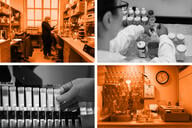You have /5 articles left.
Sign up for a free account or log in.
With federal and state officials, accreditors and others all talking about the importance of assessment, what's going on in classrooms? Assessment, after all, takes place every time a professor gives a test. A new volume of essays, Beyond Tests and Quizzes: Creative Assessments in the College Classroom (Jossey-Bass) argues that assessments in the classroom could be more creative and more useful to the educational process. The editors of the volume are Richard Mezeske, chair of education at Hope College, and Barbara A. Mezeske, an associate professor of English at Hope. In an e-mail interview, they discussed the themes of their new book.
Q: What do you see as the major failings of the tests used in most classrooms?
A: It is not that tests have failings, but that tests are limited. Conventional paper and pencil tests should not be the sole means for assessing student learning because tests are by their very nature single snapshots in time of student learning, often limited to "what do they remember" under pressure. Tests, alongside other assessment tools, can inform teaching by providing multiple lenses for considering what it is that students know and can do. If, at a given point in the semester the teacher discovers (through timely assessment) that students are not getting it, and either do not know the material, or cannot do anything with what they know (i.e., they can't apply their knowledge), then instruction can be shifted on the spot to rectify the situation. Multiple assessment tools are always preferable to the single test.
Q: How different are different disciplines in the way they use tests?
A: They vary extensively. It seems to us that some disciplines lend themselves more readily to applications or to problem-based demonstrations of learning than others. We think immediately of the social sciences, and also of any discipline which assesses students based on their writing. In the arts, skill is best demonstrated in applied fashion. Science courses with robust laboratory components afford many opportunities for creative, non-test assessment of learning.
Some disciplines rely on one, two, or three tests each semester as their sole means of assessment, and these tests are often focused on rote recall of facts. Content knowledge, to be sure, is essential, but tests (and ongoing assessments) need to give students opportunities to demonstrate not just recall, but also application. Test experiences can challenge students to a deeper level of mastery by requiring them to use facts in new and
creative ways to demonstrate understanding, and to tap into their personal schemas. Too often tests are designed to measure what students do not know: Since we all know far less than there is to know and understand at a deep level about a given topic, concept, or discipline, constructing a test to prove that is a simple matter. However, if students are to know concepts X, Y, and Z at the end of a course, then designing assessments, and yes, tests, to confirm that is a tougher process. That's because rote recall cannot be the sole indicator of knowledge and understanding. The tests or assessments have to be multifaceted and must assess multiple layers of student knowledge about X, Y, or Z.
It's just common sense to encourage learning beyond the rote level. For years, the business community has complained about employees (i.e., graduates of our schools) who cannot solve problems, who cannot work independently or collaboratively, or who need constant direction. Creating tests that measure the knowledge and skills at the levels where application can occur will not solve these problems in and of themselves, but a concerted global effort to move beyond rote learning can be a major component in developing a thoughtful, creative, and adaptable citizenry who can demonstrate knowledge and skills in new and creative ways to solve problems we cannot yet even imagine. We need to collectively move students away from the mindset that asks, "Is this on the test?" to "This is interesting. How might I use it in the future?"
Q: Could you share your definition of "creative assessment" and some of your favorite examples?
A: Creative assessment is flexible, timely, and interesting to both the instructor and to the student. When teachers shift instruction based on student feedback, then they are being flexible and creative. We do not mean that teachers should design ever more imaginative and bizarre assessment tools, or that they should ignore mandated curricular content. Rather, creative assessment, as we use the term, implies focused attention to student learning, reading the signs, engaging students, and listening to their feedback. Creative assessment often gives students opportunities to apply and deepen their superficial knowledge in their discipline.
For example, in the chapter in our book about teaching grammar, Rhoda Janzen describes an assessment that requires students to devise and play grammar games: They cannot do that without a deep mastery of the principles they are learning. In another chapter, Tom Smith describes how he grades individuals' tests during private office appointments: He affirms correct responses, asks students to explain incomplete or erroneous answers, and both gives and gets immediate, personal feedback on a student's ability to recall and apply concepts. In a third chapter, David Schock writes about taking media-production skills into the community, allowing students to demonstrate their knowledge and skills by creating public service announcements and other media products for an audience outside the classroom.
Q: How is technology (the Web, etc.) changing the potential of testing and assessment?
A: Technology is expanding the possibilities for assessment while at the same time complicating assessment. For example, checking understanding of a group and individuals during instruction is now relatively simple with electronic tools which allow students to press a button and report what they believe about concept X. The results are instantaneously displayed for an entire class to see and the instructor can adjust instruction based on that feedback. However, technology can complicate, too. How is a teacher able to guarantee student X working at a remote computer station on an assessment is actually student X, and not student Y covering for student X? Does the technology merely make the assessment tool slick without adding substance to the assessment? In other words, merely using technology does not automatically make the assessment clever, substantive, correct, or even interesting, but it can do all of those things.
Q: In the national debates about assessment, many policy makers place an emphasis on comparability. How important do you think it is that tests be comparable?
A: In our experience, the best measures of learning take into account the immediate circumstances of classroom and teacher, as well as the individual learner. Good assessment tells you what people know and can do, and since people are different from one another, one learner might best demonstrate his knowledge by taking a standard pen and paper test, while another might best demonstrate his knowledge by designing a multi-media presentation. One purpose of good assessment is always to shape subsequent instruction.
Q: What are the lessons from this book for people engaged in the national debate over assessment?
A: With the pressures to move to more mandated standardized testing to determine what it is that students know, we may be limiting both teaching and learning. We have not taken a stand against standardized tests -- they're the law, and we do them. However, such tests should not be the sole means for determining what makes for a well-equipped and knowledgeable citizen of the 21st century. If teachers are focused on a mandated lesson and rote recall of facts in that lesson, they may shortchange students who need one more opportunity to consider the concepts in ways which might be personally meaningful and are connected to personal schema or prior knowledge. But if checking in with students periodically about what they know and understand allows for subtle shifts in teaching to reinforce concepts, even while state and national mandates are met, then we are all better off.




